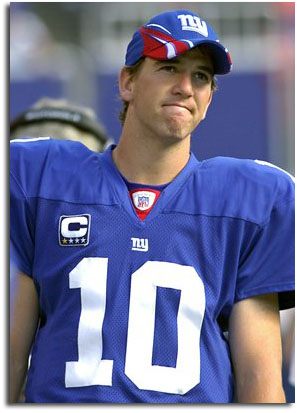| Class of 2004 Quarterback Contract Extensions | |||
| Player | Roethlisberger | Manning | Rivers |
| Club | PIT | NYG | SD |
| Sign Date | 3/3/2008 | 8/14/2009 | 8/25/2009 |
| New Years | 6 | 6 | 6 |
| Guarantee | $33,200,000 | $35,000,000 | $38,150,000 |
| Guarantee/Year | $5,533,333 | $5,833,333 | $6,358,333 |
| Guarantee vs Total New Money | 37.7% | 35.9% | 41.6% |
| Non-Guaranteed Money | $54,786,502 | $62,500,000 | $53,650,000 |
| Total New Money | $87,986,502 | $97,500,000 | $91,800,000 |
| Average Per Year | $14,664,417 | $16,250,000 | $15,300,000 |
| Three-Year Total | $52,686,501 | $50,850,000 | $50,250,000 |
| Guarantee vs Three Year Total | 63.0% | 68.8% | 75.9% |
One could make the argument that what the 1983 Quarterback draft class is to Hall of Famers, the 2004 Quarterback draft class is to hefty contract extensions. With Philip Rivers signing his contract earlier this week, it makes sense to compare the contracts of this highly compensated group of quarterbacks.
Given the unguaranteed nature of NFL contracts, I’m of the opinion that guaranteed money is the most important metric by which to judge contracts. With that in mind, when one compares the three contracts, Philip Rivers’ deal comes out on top. In my Eli Manning analysis article from earlier this month, I wrote that Rivers’ contract could “approach $40 million guaranteed and $100 million in new money…Sounds a lot like the Haynesworth contract.” While Rivers did not get nearly $100 million in new money, he did get $38.15 million guaranteed - $3 million more than Manning and nearly $5 million more than Roethlisberger. Another good metric is to look at how much guaranteed money a player is getting compared to the number of years they are obligating themselves to; in the case of Rivers, his guarantee per year of $6.36 million easily exceeds Manning and Roethlisberger and Haynesworth ($5.86 million) for that matter.
The give and take of Rivers’ contract appears to be that in exchange for his high guaranteed money, he sacrificed the total value of his contract. Of the three contracts, Manning’s contract easily has the highest total new money value, $97.5 million; however, Manning also has the lowest percentage of his contract guaranteed, 35.9%. Conversely, Rivers has a total new money value that is nearly $6 million less than Manning, but the 41.6% of his contract that is guaranteed is the highest amongst this group. One could surmise that the fact that so much of Manning’s contract, relative to his quarterback peers of 2004, is non-guaranteed reflects the inconsistency of his play compared to that of his peers.
The three-year total metric is often the most utilized and practical barometer of total contract value since the likelihood of a player making it to the latter years of a deal isn’t very likely. That said, Roethlisberger is going to make the most new money over the first three years of the contract, $52.67 million, while Rivers is going to make the least of this group of quarterbacks, $50.25 million. However, Rivers’ 75.9% of his three-year total being guarantee leads this group, which goes back to the point that Rivers sacrificed non-guaranteed money for more guaranteed money.
So what does this mean for the Tom Bradys and Peyton Mannings of the world? Given that quarterbacks can play well into their 30’s, perhaps six year extensions can be in their futures despite their ages (Brady, 32; Manning, 34). Moreover, if the quarterback class of 2004 is getting around $6 million per year in guaranteed money, then Brady and Manning could easily command $7 million per year in guaranteed money (particularly if Matthew Stafford got $6.95 million per year). Another possible structure could be an average new money per year of nearly $20 million per year, but with roughly 25% of the total new money guaranteed (roughly $30 million guaranteed on a six year deal). This is the approach the Packers took with 31-year old Brett Favre in 2001; it’s called the “pay as you go approach,” which seems fitting for a player heading towards the perceived twilight of their career.
With the rare exception of the Albert Haynesworth’s of the world, it’s clear, and not necessarily a surprise, that quarterback is the money position in the NFL. Many front offices believe that a legitimate franchise quarterback single-handedly gives your club a better chance of succeeding; which makes the trade of Jay Cutler somewhat of an eyebrow raiser, but the subscription to this philosophy is also reflected in the value of the quarterback market. The 2004 quarterback draft class exemplifies this fact; stay tuned to see if in 2014, the 2009 quarterback draft class of Stafford, Sanchez, and Freeman cash in like their 2004 predecessors.
